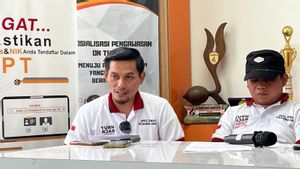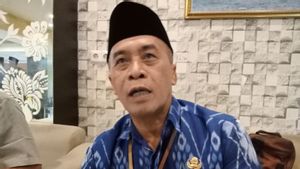JAKARTA - As an archipelago, Indonesia has a diversity of ethnicities and cultures. Every region in Indonesia has its own traditional dance. The dances in each region have different characteristics, ranging from movements, costumes, to dancers.
Regional or traditional dances will require local values. Each dance contains elements of belief, geographic, historical, and social society in each region. You can imagine the richness of Indonesian dances from Sabang to Merauke.
This article will present dances from one of the regions in eastern Indonesia, namely East Nusa Tenggara. NTT's culture is famous for being exotic and beautiful. Because it consists of a cluster of islands, this province has a variety of tribes. This is what led to 21 NTT regional dances.
To get to know more, let's take a look at some of the following East Nusa Tenggara dances.
Kebalai Dance from Rote
This dance is the result of the culture of the people in Rote. This dance is performed in an event after the traditional eating process. Kebalai Dance is performed by many people because it is massive, all ages are welcome to join.
When performing this dance, people gather in a circle. They danced while following the chanting of Manahelo and Masimba. The two names are nicknames for poet speakers. Foot movements are the most dominant in this dance.
The Kebalai dance serves to entertain families who are experiencing grief. In addition, this dance is also useful for strengthening togetherness, social relations, and unity.
The existence of Kebalai Dance can still be found today. The people of Rote still preserve it and introduce it to the outside community. To be able to survive in the era of the times. Masuarakat Rote combines this dance in cultural festival events.
Caci dance from Manggarai
Another famous traditional NTT dance is the Caci Dance. The Caci dance originates from Manggarai. This dance contains elements of martial arts or physical fighting. The people of NTT usually perform this dance during the harvest season as a form of gratitude for the abundance of crops.
The Caci dance is performed by two dancers, who are usually men. The two dancers wore clothes like soldiers' clothes and fought. The clothes are in the form of a head covering or mask made of buffalo skin.
The dancers carry weapons in the form of whips and shields. They will fight to the accompaniment of gongs, drums, and Neggo / dare chants from the supporters. Apart from being danced at harvest time, the Caci Dance is also used for other traditional ceremonies.
Lego dance from Alor
The Lego dance is a unique traditional dance from NTT. This dance comes from the culture of the Abui people, who live in Alor. Dancers in this dance do not have a number limit, such as groups, pairs, or only a few people.
The Lego dance was performed en masse. Everyone at the venue became a dancer. The dancers will gather, then join hands. In the center of the circle is a three stone arrangement (Mesbah). Mesbah is a sacred object for the Abuy tribe.
The dancers wear traditional clothes which are quite interesting. Their feet are studded with silver bracelets. The bracelet will produce a jingling sound when the dancer moves swiftly. During the performance, the community will also sing traditional language rhymes and songs.
Another uniqueness of this dance is the duration of its performance. The Lego dance is performed all night long. This dance is a symbol of the strength and unity of the Abui people.
Cerana dance from Kupang
NTT has a quite famous guest welcoming dance called Cerana Dance. This dance is synonymous with the symbols of betel and areca nut dishes. There is a deep meaning to the dish, which means acceptance.
Cerana dance is usually performed by 6 female dancers and one male dancer who wears traditional clothes. The female dancer will sway gracefully. While the male dancers carry betel and areca nut with dashing movements. Female dancers will accompany male dancers to deliver dishes to invited guests.
Kataga dance from West Sumba
This traditional NTT dance is a type of war dance. Kataga dance originates from West Sumba. Now this dance is used to be staged during cultural arts performances and welcoming guests. Kataga dance is performed by 8 pira dancers who wear traditional Sumba clothes.
The 8 people danced with weapons of war, in the form of swords and shields. Dancers also wear headbands and small bells that are attached to the dancer's body. The jingling of the bells will add to the festivity of the dance performance. The gong instrument also adds to the tense atmosphere.
Gawi Dance
Gawi dance is a traditional dance from the Ende Lio Tribe. This dance is performed to express gratitude for the abundance of grace given by God. The word 'ga' means reluctant or hesitant. Meanwhile, the word 'wi' means attractive. These two words, when combined, have the meaning of unifying oneself with the almighty.
This dance has been performed since the time of the ancestors of the Ende Lio Tribe. According to historical records found, this dance was once performed at the closing of a traditional event. This indicates that the Gawi Dance is performed to convey gratitude.
Gawi dance is performed en masse. The dancers form a circle and hold hands. This dance is usually performed at harvest ceremonies, the appointment of traditional chiefs, house construction, and other traditional events.
The Pestle Rough Dance
The Rangkok Alu Dance is a dance that has elements of traditional games. This dance comes from Manggarai, Flores. The beginning of the creation of this dance comes from a traditional game called r bowl alu.
Rangku pestle is a traditional game that uses bamboo tools. This game uses four bamboo blades. The four players will squat and move the bamboo, crossing each other. Semantar the other players will be in the middle of the bamboo and jumping around between the bamboos.
The movement of the rangkok pestle dance is the same as the game concept Like traditional games in general, this dance is useful for training agility, balance, and sensitivity. In addition, this dance also contains spiritual and philosophical values according to the beliefs of the people.
Those were some types of dances from East Nusa Tenggara. Every dance has its own function. These dances are one of Indonesia's cultural treasures. The people of NTT still preserve these traditional dances until now and are integrated with modern culture.
* Stay up to date with the latest domestic and foreign news on VOI.
BERNAS OthersThe English, Chinese, Japanese, Arabic, and French versions are automatically generated by the AI. So there may still be inaccuracies in translating, please always see Indonesian as our main language. (system supported by DigitalSiber.id)









